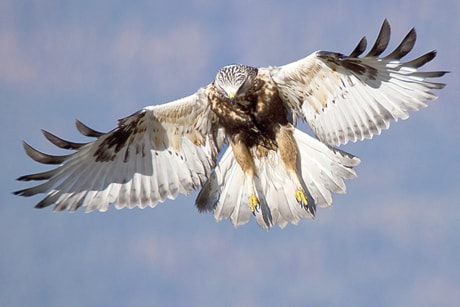Last Monday we had a wonderful birding day.
We saw a western meadowlark, green-winged teal, ring-necked duck, canvasback, American coot, and Brewer’s blackbirds.
All of these birds were first sightings of the season for me, but the highlight of the day had to be the number of raptors we saw: one osprey, one prairie falcon, two northern harriers, three bald eagles, four American kestrels, 24 rough-legged hawks and the topper for the day: 53 red-tailed hawks.
We must have gotten in the middle of a migration.
I don’t think I’ve ever seen that many rough-legged hawks on the same day before.
Right now they are moving north, up to the Arctic tundra, their normal nesting area.
In the fall they move through our area to go south for the winter. So we only get to see them in the spring and fall and, thus, need to enjoy them while we can.
I think I’m going to have to take a trip up north one of these summers; otherwise, I’ll never see a nesting rough-leg.
From various resources, I found out that they nest on the tundra, usually in areas where there are cliffs because they nest on a narrow ledge or niche on a high cliff.
Kenn Kaufman in Lives of North American Birds says that they can also nest on the edge of forest, where they will nest in trees. He says the “nest is a bulky structure of sticks, bones, debris, lined with grasses and twigs.” One source I looked at on the Internet said that sometimes caribou bones can be found in the lining of their nests.
Rough-legged hawks are usually fairly distinctive. The “classic” rough-leg has a huge dark belly band, light coloured head, white tail with a dark band at the bottom, and dark wrist patches on the wings when seen in flight.
But one of the 24 rough-legs we saw was a strange one. It had almost the Swainson’s hawk’s bib on the neck, but it definitely had the dark banded white tail of a rough-leg. I looked in the Golden Field Guide later, though. In there, it says “Some adults have only brown barring on the belly.” That is what this particular bird had. It did not have the characteristic dark belly band so that is what really threw us off with our identification.
There are so many variations in colouring for the hawks. Many years ago, I took a hawk identification course.
We avidly listened to our instructor give us the field marks of all the hawks and wrote copious notes. At the end of the day, he told us to throw out all of our notes because there were so many different morphs and phases and combinations of colours, that our notes would not be very helpful.
That’s why when I look at a field guide, I look at how many different variations they show for the hawk species.
The more they show, the easier it is to identify the bird in the field and so, the more helpful the field guide will be.
With Monday being such a great birding day, I can hardly wait for what we might find the next time we go out. I still need to see red-winged blackbirds, Swainson’s hawks, shorebirds, pelicans, and the list goes on. The birding can only keep getting better.
Judy Boyd is a naturalist with the Red Deer River Naturalists.
